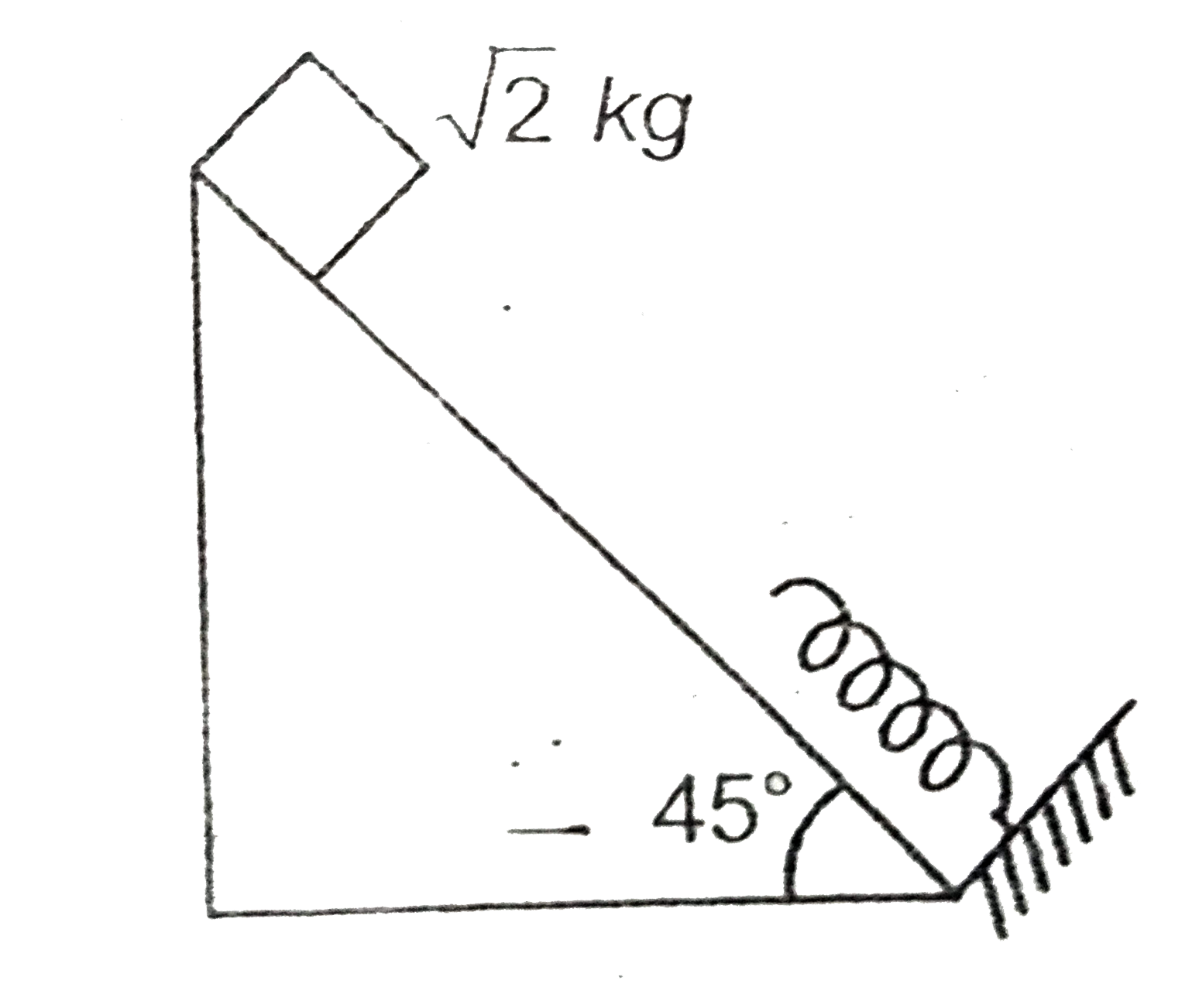A lift a mass 1200kg is raised from rest by a cable with a tension 1350kgf . After same time the tension drops to 1000kgf and the lift comes to rest at a height of 25m above its intial point (1kg−f=9.8N)
What is the greatest speed of lift?
9.8ms−1
7.5ms−1
5.92ms−1
None of these
The correct Answer is:C
To solve the problem step by step, we will analyze the motion of the lift in two phases: the acceleration phase and the deceleration phase.
Step 1: Calculate the acceleration when the tension is 1350 kgf
1. Convert the tension from kgf to Newtons:
T1=1350kgf×9.8N/kgf=13230N
2. Calculate the weight of the lift:
W=m⋅g=1200kg×9.8N/kg=11760N
3. Determine the net force acting on the lift:
Fnet=T1−W=13230N−11760N=1470N
4. Calculate the acceleration using Newton's second law:
a1=Fnetm=1470N1200kg=1.225m/s2
Step 2: Calculate the distance traveled during acceleration
1. Use the kinematic equation to find the distance (h1) during acceleration:
Since the lift starts from rest, we can use the formula:
h1=12a1t2
We will need to find the time (t) later.
Step 3: Calculate the deceleration when the tension drops to 1000 kgf
1. Convert the tension from kgf to Newtons:
T2=1000kgf×9.8N/kgf=9800N
2. Determine the net force during deceleration:
Fnet=T2−W=9800N−11760N=−1960N
3. Calculate the deceleration:
a2=Fnetm=−1960N1200kg=−1.6333m/s2
Step 4: Calculate the distance traveled during deceleration (h2)
1. The total height the lift travels is 25 m:
h1+h2=25m
2. Using the kinematic equation for deceleration:
v2=u2+2a2h2
where u is the maximum speed reached at the end of the acceleration phase.
Step 5: Relate the maximum speed to the distances and accelerations
1. Using the relationship:
v2=2a1h1=−2a2h2
2. From the previous steps, we can express h2 in terms of h1:
h2=25−h1
Step 6: Solve for maximum speed (v)
1. Substituting the values:
v2=2⋅1.225⋅h1=−2⋅(−1.6333)⋅(25−h1)
2. Solving the equations simultaneously will give us the maximum speed:
After calculations, we find:
v=5.92m/s
Final Answer
The greatest speed of the lift is 5.92m/s.
---
T1=1350kgf×9.8N/kgf=13230N
W=m⋅g=1200kg×9.8N/kg=11760N
Fnet=T1−W=13230N−11760N=1470N
a1=Fnetm=1470N1200kg=1.225m/s2
Since the lift starts from rest, we can use the formula:
h1=12a1t2
We will need to find the time (t) later.
T2=1000kgf×9.8N/kgf=9800N
Fnet=T2−W=9800N−11760N=−1960N
a2=Fnetm=−1960N1200kg=−1.6333m/s2
h1+h2=25m
v2=u2+2a2h2
where u is the maximum speed reached at the end of the acceleration phase.
v2=2a1h1=−2a2h2
h2=25−h1
v2=2⋅1.225⋅h1=−2⋅(−1.6333)⋅(25−h1)
After calculations, we find:
v=5.92m/s
The greatest speed of the lift is 5.92m/s.
Topper's Solved these Questions
- BOOK - DC PANDEY ENGLISHCHAPTER - LAWS OF MOTIONEXERCISE - Subjective Question27videos
LAWS OF MOTION
- BOOK - DC PANDEY ENGLISHCHAPTER - LAWS OF MOTIONEXERCISE - Check point 5.120videos
LAWS OF MOTION
- BOOK - DC PANDEY ENGLISHCHAPTER - LAWS OF MOTIONEXERCISE - Objective Question32videos
LAWS OF MOTION
- BOOK - DC PANDEY ENGLISHCHAPTER - KINEMATICS 1EXERCISE - INTEGER_TYPE15videos
KINEMATICS 1
- BOOK - DC PANDEY ENGLISHCHAPTER - LAWS OF THERMODYNAMICSEXERCISE - Level 2 Subjective18videos
LAWS OF THERMODYNAMICS
Similar Questions
A lift a mass 1200kg is raised from rest by a cable with a tension 1350kgf . After same time the tension drops to 1000kgf and the lift comes to rest at a height of 25m above its intial point (1kg−f=9.8N)
What is the height at which the tension changes ?View SolutionA lift starts from rest. Its acceleration is plotted against time. When it comes to rest its height above its starting point is
 View Solution
View Solution
Knowledge Check
- Question 1 - Select One
If a body of mass 5 kg is lifted from the ground level to a height of 5m then ratio of its inertia is …………..
A1:1BsameCconstantDnot defined
A particle of mass 1 kg is released from rest at a point where gravitational potential is 5 J/kg. After some time, it passes through a point B with a speed of 1 m/s. What is the gravitational potential at B ?
View SolutionA lift of mass 100 kg is moving upwards with an acceleration of 1 m/s2. The tension developed in the string, which is connected to lift is (g=9.8m/s2)
View SolutionA block of mass √2 kg is released from the top of an inclined smooth surface as shown in fighre. If spring constant of spring is 100 N/m and block comes to rest after compressing the spring by 1 m, then the distance travelled by block befor it comes to rest is
 View Solution
View SolutionA block of mass √2 kg is released from the top of an inclined smooth surface as shown in fighre. If spring constant of spring is 100 N/m and block comes to rest after compressing the spring by 1 m, then the distance travelled by block befor it comes to rest is
 View Solution
View SolutionA lift of mass 1000kg is moving with an acceleration of 1m/s2 in upward direction. Tension developed in the string, which is connected to the lift, is.
View SolutionA lift of mass 1000kg is moving with an acceleration of 1m/s2 in upward direction. Tension developed in the string, which is connected to the lift, is.
View SolutionA 1000 kg lift is supported by a cable that can support 2000 kg. The shortest distance in which the lift can be stopped when it is descending with a speed of 2.5m/s is (g=10m/s2)
View Solution

